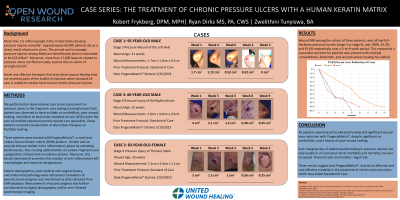Case Series/Study
(CS-061) Case Series: The Treatment of Chronic Pressure Ulcers with a Human Keratin Matrix

More than 2.5 million people in the United States develop pressure ulcers annually. Not only do pressure ulcers increase the risk of serious infection and death for the patient, but they also cause increased healthcare utilization and cost for the healthcare system at large. Chronic pressure ulcers represent the most challenging subset.
Methods:
We performed an observational case series assessment on pressure ulcers in the long-term care setting (nursing home). Each patient was observed to have multiple co-morbidities, poor wound healing, and failure under standard-of-care (SOC). These patients received consideration of alternative therapies to facilitate healing.
Three patients were treated with human keratin matrix (HKM). Patient demographics, past medical and surgical history, and anatomical pathology were articulated. Evaluation of wound closure progress was followed with the participation of a certified wound specialist. Measurement of wound progress was via digital photography, and/or near-infrared spectroscopy imaging.
Results:
Wound closure amongst the cohort of three patients, who all had full-thickness pressure ulcers[ (stage 3 or stage 4), was 100%, 74%, and 55% respectively, over a 2–4-week period.
Discussion:
All patients experienced accelerated healing and significant wound area reduction with HKM despite significant co-morbidities, and a history of poor wound healing. These results suggest that HKM may be an effective and cost-effective modality in the treatment of chronic pressure ulcers which have failed SOC.
Trademarked Items:
References:

.png)